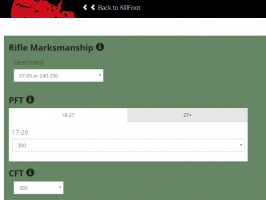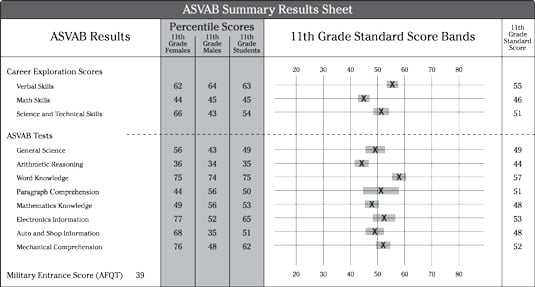Composite Score Conversion Chart Usmc Free For Mac
- Composite Score Conversion Chart Usmc Free For Macs
- Composite Score Conversion Chart Usmc Free For Mac Download
- Composite Score Conversion Chart Usmc Free For Mac Os
- Composite Score Conversion Chart Usmc Free For Macbook Pro
Score Calculator KillFoot »» Marine Corps Cutting Scores - Select - Prior Service Programs Contact Us Composite Score Calculator Guides Marine Corps PSR Contacts Ask a Recruiter Marine Corps Cutting Scores Reserve Sergeant Cutting Scores Reserve Corporal Cutting Scores Active Duty Sergeant Cutting Scores Active Duty Corporal Cutting Scores.
CogAT scoring is based on your child’s age (not grade level). Your child will receive what’s called an SAS, or “Standard Age Score,” which compares your child’s score against other children in the same age range. The highest SAS that a child can receive on the CogAT is 160, while 100 is considered to be an average score.
Here are all the steps used to calculate a child’s unique test score:
- Raw Score. This is total number of questions answered correctly; however, incorrect answers do not cause points to be deducted from the overall raw score.
- Universal Scale Score (USS). After the Raw Score is determined, it’s converted to a normalized standard score known as the Universal Scale Score. There are separate USS scores for each of the test’s three verbal, nonverbal and quantitative reasoning skills subsections (also called “batteries”). The Composite USS is determined by averaging these three different scores.
- Standard Age Score (SAS). The Standard Age Score has a maximum possible score of 160; the average score is 100.
- Percentile Rank (PR). School districts use this number to compare students that share the same age and grade level. A percentile rank of 80 means that child’s score was higher than 80% of students who took the same test. The average percentile rank is 50.
- Stanine (S). A stanine is a very broad, simplified score ranging from 1 (lowest) to 9 (highest possible), and it’s normalized for the child’s age and grade level.

- Second, the military uses the following formula to calculate your AFQT score: 2VE + AR + MK. Here are s tep-by-step directions. Double the VE score (VE score x 2) Then they add the result of step 1 to the Arithmetic Reasoning (AR) and Math Knowledge (MK) totals (1-3 point per correct answer).
- The cutting score for June will be based on your May appraisals and come out the first part of June. It is too late to do much to change your score. You can search on May 2012 cutting scores for your MOS and you should be able to get an idea of what the cutting score will be. The May scores should be online and you should have access to them.
Each stanine is made up of a range of percentile ranks. The table below shows the percentile ranks that formulate each stanine and the associated ability level.
| Stanine | Percentile Rank | Description |
|---|---|---|
| 9 | 96-99 | Very High |
| 8 | 89-95 | Above Average |
| 7 | 77-88 | Above Average |
| 6 | 60-76 | Average |
| 5 | 40-59 | Average |
| 4 | 23-39 | Average |
| 3 | 11-22 | Below Average |
| 2 | 4-10 | Below Average |
| 1 | 1-3 | Very Low |
Want to try us out? Sign up for a free account today and get 100 gifted and talented practice questions.
Understanding Your Scores


Use this interactive document to learn more about how to read and use information in the ACT Student Report.
Make Sense of Your Scores
Learn what goes into your composite score and how to use it.

What’s in a composite score? Your number of correct answers converts to a score that ranges from 1 to 36 for each of the four tests—and your composite score is the average of those.
But it’s what you do with your scores now that really matters.
Composite Score Conversion Chart Usmc Free For Macs
Looking for an older version of Score Reports or Using Your ACT Results? Check our Resources page for educators.
Composite Score Conversion Chart Usmc Free For Mac Download
You may be wondering if you’re ready for college or if the major you’re considering is a good fit for you. Knowing how to use the right planning tools can help you navigate this time in your life.
For explanations of the different sections of your ACT score report and how you can use it to make decisions about college and beyond, download this FREE eBook.
How ACT Figures the Multiple-Choice and Composite Scores
From Reporting Category to Composite
Composite Score Conversion Chart Usmc Free For Mac Os
You’ve answered the questions and we’ve scored the results. Here’s how:
- First we counted the number of questions on each test that you answered correctly. We did not deduct any points for incorrect answers. (There is no penalty for guessing.)
- Then we converted your raw scores (number of correct answers on each test) to 'scale scores.' Scale scores have the same meaning for all the different forms of the ACT® test, no matter which date a test was taken.
- Your Composite score and each test score (English, mathematics, reading, science) range from 1 (low) to 36 (high). The Composite score is the average of your four test scores, rounded to the nearest whole number. Fractions less than one-half are rounded down; fractions one-half or more are rounded up.
- Each reporting category includes the total number of questions in that category, the total number of questions in that category you answered correctly, and the percentage of questions correct. ACT reporting categories are aligned with ACT College and Career Readiness Standards and other standards that target college and career readiness.
How Do Tests, Questions, and Reporting Categories Relate to One Another?
For additional information about reporting categories and your scores check out:
| Test | Number of Questions | Reporting Categories |
|---|---|---|
| English | 75 | Production of Writing (29-32%) Knowledge of Language (13-19%) Conventions of Standard English (51-56%) |
| Mathematics | 60 | Preparing for higher math (57-60%)
Integrating essential skills (40-43%) Modeling |
| Reading | 40 | Key ideas and details (55-60%) Craft and structure (25-30%) Integration of knowledge and ideas (13-18%) |
| Science | 40 | Interpretation of data (45-55%) Scientific investigation (20-30%) Evaluation of Models, inferences, and experimental results (25-35%) |
Standards and Benchmarks
For College and Career Readiness
The Benchmarks are scores on the ACT subject-area tests that represent the level of achievement required for students to have a 50% chance of obtaining a B or higher or about a 75% chance of obtaining a C or higher in corresponding credit-bearing first-year college courses. These college courses include English composition, college algebra, introductory social science courses, and biology. Based on a sample of 214 institutions and more than 230,000 students from across the United States, the Benchmarks are median course placement values for these institutions and as such represent a typical set of expectations.
Scoring for the Writing Test
Composite Score Conversion Chart Usmc Free For Macbook Pro
Taking the ACT with writing will provide additional scores to you and the schools to which you have ACT report scores. Find more information about how the writing test is scored.
What are National Ranks?
Your national ranks tell you how your scores compare to those earned by recent high school graduates who took the ACT. Find out more about your test scores and how they relate to ACT College and Career Readiness Standards.
ACT / SAT Concordance

ACT and the College Board have completed a concordance study that is designed to examine the relationship between scores on the ACT test and the SAT. These concordance tables do not equate scores, but rather provide a tool for finding comparable scores.
